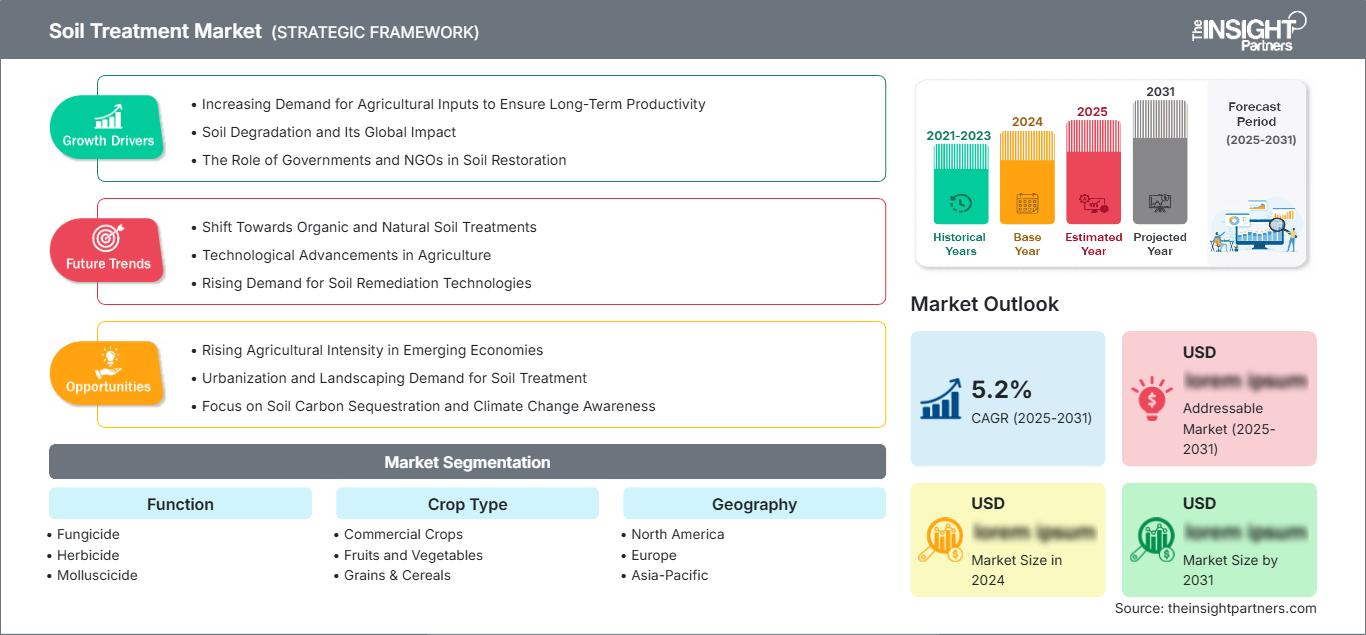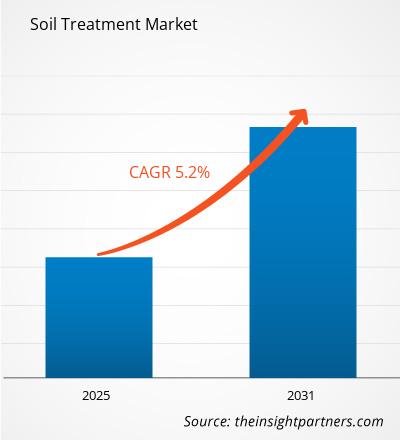Der Markt für Bodenbehandlung wird voraussichtlich zwischen 2025 und 2031 eine durchschnittliche jährliche Wachstumsrate (CAGR) von 5,2 % verzeichnen, wobei die Marktgröße von XX Millionen US-Dollar im Jahr 2024 auf XX Millionen US-Dollar im Jahr 2031 anwachsen wird.
Der Bericht ist nach Funktion segmentiert (Fungizid, Herbizid, Molluskizid, Insektizid und Nematizid). Der Bericht enthält außerdem eine Analyse basierend auf der Anbauart (kommerzielle Nutzpflanzen, Obst und Gemüse, Getreide und Cerealien, Hülsenfrüchte und Ölsaaten sowie Rasen und Zierpflanzen). Der Bericht umfasst fünf Regionen: Nordamerika, Europa, Asien-Pazifik, Naher Osten und Afrika sowie Süd- und Mittelamerika und die wichtigsten Länder jeder Region. Die globale Analyse ist weiter auf regionaler Ebene und nach den wichtigsten Ländern aufgeschlüsselt. Der Bericht bietet den Wert in USD für die oben genannte Analyse und Segmente.
Zweck des Berichts
Der Bericht „Markt für Bodenbehandlung“ von The Insight Partners zielt darauf ab, die aktuelle Situation und das zukünftige Wachstum sowie die wichtigsten treibenden Faktoren, Herausforderungen und Chancen zu beschreiben. Dies wird verschiedenen Geschäftspartnern Einblicke bieten, wie z. B.:
- Technologieanbieter/-hersteller: Um die sich entwickelnde Marktdynamik zu verstehen und die potenziellen Wachstumschancen zu kennen, damit sie fundierte strategische Entscheidungen treffen können.
- Investoren: Um eine umfassende Trendanalyse hinsichtlich der Marktwachstumsrate, der finanziellen Marktprognosen und der Chancen entlang der Wertschöpfungskette durchzuführen.
- Regulierungsbehörden: Um Richtlinien und Überwachungsaktivitäten auf dem Markt zu regulieren, mit dem Ziel, Missbrauch zu minimieren, das Vertrauen der Investoren zu wahren und die Integrität und Stabilität des Marktes aufrechtzuerhalten.
Marktsegmentierungsfunktion für Bodenbehandlung
- Fungizid
- Herbizid
- Molluskizid
- Insektizid
- Nematizid
Pflanzenart
- Gewerbliche Nutzpflanzen
- Obst und Gemüse
- Getreide und Cerealien
- Hülsenfrüchte und Ölsaaten
- Rasen und Zierpflanzen
Sie erhalten kostenlos Anpassungen an jedem Bericht, einschließlich Teilen dieses Berichts oder einer Analyse auf Länderebene, eines Excel-Datenpakets sowie tolle Angebote und Rabatte für Start-ups und Universitäten.
Markt für Bodenbehandlung: Strategische Einblicke

-
Holen Sie sich die wichtigsten Markttrends aus diesem Bericht.Dieses KOSTENLOSE Beispiel umfasst Datenanalysen, die von Markttrends bis hin zu Schätzungen und Prognosen reichen.
Wachstumstreiber im Markt für Bodenbehandlung
- Steigende Nachfrage nach landwirtschaftlichen Betriebsmitteln zur Sicherung langfristiger Produktivität: Die wachsende Weltbevölkerung und der damit verbundene Bedarf an landwirtschaftlichen Produkten erfordern höhere Betriebsmittel für die Böden, um eine ordnungsgemäße Behandlung zu gewährleisten und so die landwirtschaftliche Produktivität langfristig zu steigern und eine nachhaltige Nahrungsmittelproduktion zu ermöglichen. Düngung, pH-Wert-Anpassung und organische Bodenverbesserungsmittel sind von entscheidender Bedeutung, da sie die Bodengesundheit und die Maximierung des Ernteertrags beeinflussen und eine langfristige landwirtschaftliche Produktivität und Ertragssteigerung gewährleisten. Ein hoher landwirtschaftlicher Ertrag erfordert eine effizientere Lösung für die Bodenbehandlung.
- Bodendegradation und ihre globalen Auswirkungen: Übernutzung landwirtschaftlicher Flächen, Abholzung, Industrialisierung und die mit Bodendegradation verbundene globale Erwärmung bedrohen die Welt. Die größten Herausforderungen in diesem Bereich sind Bodenerosion, Nährstoffmangel und Kontamination. Dies erfordert den Einsatz von Bodenaufbereitung, Bodenerosionskontrolle und -sanierung, um die Wiederherstellung und Erhaltung gesunder Böden zu verbessern. Regierungen, NGOs und mit der Agrarindustrie verbundene Industrien haben ein Interesse daran, den Boden zu behandeln, um die akkumulierten negativen Auswirkungen unsachgemäßer Bodenbewirtschaftung rückgängig zu machen.
- Die Rolle von Regierungen und NGOs bei der Bodensanierung: Das zunehmende Bewusstsein für Umweltfaktoren und strenge staatliche Vorschriften zur Bodenbehandlung mit nachhaltigen landwirtschaftlichen Produkten fördern die Einführung von Bodenbehandlungsprodukten. Biologische und umweltfreundliche Behandlungen sind aufgrund ihrer Umweltverträglichkeit die erste Wahl für Landwirte, da die Kunden den Einsatz von Chemikalien in der Landwirtschaft minimieren und die Verschmutzung von Boden und Wasser vermeiden möchten. Landwirtschaftliche Vorschriften verlangen bei der Bodenbehandlung die strikte Einhaltung landwirtschaftlicher Prinzipien für eine sichere und gesunde Landwirtschaft.
Zukünftige Trends im Markt für Bodenbehandlung
- Umstellung auf biologische und natürliche Bodenbehandlungen: Biologische und natürliche Bodenbehandlungen wie Kompost, Biokohle und pflanzliche Düngemittel nehmen zu. Dies liegt daran, dass die Verbraucher mehr Bio-Produkte bevorzugen und strengere Umweltvorschriften eine schadstofffreie und nachhaltige Bodenbewirtschaftung vorschreiben. Biobasierte Bodenbehandlungen gewinnen auch aufgrund ihrer höheren Umweltfreundlichkeit und Sicherheit im Vergleich zu synthetischen chemischen Produkten an Bedeutung.
- Technologischer Fortschritt in der Landwirtschaft: Neue Technologien und deren Einsatz in der Landwirtschaft verändern die Bodenbehandlung. Datenanalyse, IoT-Geräte, Drohnen und andere Sensoren prägen die Präzisionslandwirtschaft. Gezielte Behandlungen ermöglichen zudem eine zeitnahe Überwachung des Bodenzustands. Diese Technologien stellen sicher, dass Bodendünger nicht verschwendet wird, indem sie Abfall minimieren und eine optimale Gesamteffizienz bei der Bodenbehandlung erreichen. Der Einsatz zugänglicherer Technologien dürfte deren Nutzung auf dem Markt für Bodenbehandlungen steigern.
- Steigende Nachfrage nach Bodensanierungstechnologien: Die steigende Nachfrage nach Bodensanierungstechnologien wird durch Bodenkontaminationen mit Schwermetallen, Pestiziden, Industrieabfällen und anderen Schadstoffen ausgelöst. Die stetig steigende Nachfrage nach umweltfreundlichen Sanierungstechnologien wie Bioremediation und Phytoremediation zur Dekontamination und Sanierung verschmutzter Böden zeigt erste Marktstärke. Die wichtigsten Triebkräfte hinter diesem Trend sind ein gestiegenes Umweltbewusstsein, neue Gesetze gegen industrielle Verschmutzung und die Notwendigkeit sauberer, gesunder Böden für Landwirtschaft und städtische Bedürfnisse.
Marktchancen für Bodenbehandlung
- Steigende landwirtschaftliche Intensität in Schwellenländern: Die zunehmende landwirtschaftliche Intensität in Schwellenländern, insbesondere im asiatisch-pazifischen Raum, Lateinamerika und Afrika, führt zu einer steigenden Nachfrage nach Bodenbehandlungstechnologien. Genau die Probleme dieser Schwellenländer – schlechte Bodenbewirtschaftung und Überbewirtschaftung in vielen Teilen – bieten Unternehmen Chancen im Bereich Bodenbehandlungstechnologien wie organische Bodenverbesserungsmittel, pH-Kontrolle und Wiederherstellung der Bodengesundheit.
- Nachfrage nach Bodenbehandlung in Urbanisierung und Landschaftsbau: Mit zunehmender Urbanisierung und Kommerzialisierung steigt der Bedarf an Bodenbehandlung in Landschaftsbauprojekten ständig an. Sie ist zu einer wesentlichen Voraussetzung geworden, um das Wachstum von Pflanzen unter rauen städtischen Bedingungen zu fördern, von Stadtparks über Gründächer bis hin zu Sportplätzen. Bodenverbesserer, Düngemittel und Erosionsschutzmittel sind für gesunde und nachhaltige Städte von entscheidender Bedeutung. Dies wiederum eröffnet neue Marktentwicklungsmöglichkeiten für Unternehmen, die Bodenbehandlung betreiben.
- Fokus auf Kohlenstoffbindung im Boden und Bewusstsein für den Klimawandel: Mit dem wachsenden Bewusstsein für den Klimawandel rückt die Kohlenstoffbindung im Boden langsam, aber stetig in den Fokus. Dazu gehören große Mengen Biokohle, Kompost und Zwischenfrüchte, die die Aufnahme- und Speicherfähigkeit des Bodens verbessern. Solche Methoden gewinnen im Rahmen größerer Carbon-Farming-Initiativen an Anerkennung und eröffnen Unternehmen, die Bodenbehandlungsmittel zur Unterstützung der Kohlenstoffbindung entwickeln, neue Möglichkeiten.
Markt für Bodenbehandlung
Die Analysten von The Insight Partners haben die regionalen Trends und Faktoren, die den Markt für Bodenbehandlung im Prognosezeitraum beeinflussen, ausführlich erläutert. In diesem Abschnitt werden auch die Marktsegmente und die geografische Lage in Nordamerika, Europa, dem asiatisch-pazifischen Raum, dem Nahen Osten und Afrika sowie Süd- und Mittelamerika erörtert.Umfang des Marktberichts zur Bodenbehandlung
| Berichtsattribut | Einzelheiten |
|---|---|
| Marktgröße in 2024 | US$ XX million |
| Marktgröße nach 2031 | US$ XX Million |
| Globale CAGR (2025 - 2031) | 5.2% |
| Historische Daten | 2021-2023 |
| Prognosezeitraum | 2025-2031 |
| Abgedeckte Segmente |
By Funktion
|
| Abgedeckte Regionen und Länder |
Nordamerika
|
| Marktführer und wichtige Unternehmensprofile |
|
Marktdichte der Akteure im Bereich Bodenbehandlung: Auswirkungen auf die Geschäftsdynamik verstehen
Der Markt für Bodenbehandlungsmittel wächst rasant. Die steigende Nachfrage der Endverbraucher ist auf Faktoren wie veränderte Verbraucherpräferenzen, technologische Fortschritte und ein stärkeres Bewusstsein für die Produktvorteile zurückzuführen. Mit der steigenden Nachfrage erweitern Unternehmen ihr Angebot, entwickeln Innovationen, um den Bedürfnissen der Verbraucher gerecht zu werden, und nutzen neue Trends, was das Marktwachstum weiter ankurbelt.

- Holen Sie sich die Markt für Bodenbehandlung Übersicht der wichtigsten Akteure
Wichtige Verkaufsargumente
- Umfassende Abdeckung: Der Bericht analysiert umfassend Produkte, Dienstleistungen, Typen und Endnutzer des Marktes für Bodenbehandlung und bietet einen ganzheitlichen Überblick.
- Expertenanalyse: Der Bericht basiert auf dem umfassenden Verständnis von Branchenexperten und Analysten.
- Aktuelle Informationen: Der Bericht gewährleistet Geschäftsrelevanz durch die Berichterstattung über aktuelle Informationen und Datentrends.
- Anpassungsoptionen: Dieser Bericht kann an spezifische Kundenanforderungen angepasst werden und passt sich optimal an die Geschäftsstrategien an.
Der Forschungsbericht zum Markt für Bodenbehandlung kann daher dazu beitragen, die Branchensituation und die Wachstumsaussichten zu entschlüsseln und zu verstehen. Obwohl es einige berechtigte Bedenken geben kann, überwiegen die Vorteile dieses Berichts tendenziell die Nachteile.
- Historische Analyse (2 Jahre), Basisjahr, Prognose (7 Jahre) mit CAGR
- PEST- und SWOT-Analyse
- Marktgröße Wert/Volumen – Global, Regional, Land
- Branchen- und Wettbewerbslandschaft
- Excel-Datensatz
Aktuelle Berichte
Verwandte Berichte
Erfahrungsberichte
Grund zum Kauf
- Fundierte Entscheidungsfindung
- Marktdynamik verstehen
- Wettbewerbsanalyse
- Kundeneinblicke
- Marktprognosen
- Risikominimierung
- Strategische Planung
- Investitionsbegründung
- Identifizierung neuer Märkte
- Verbesserung von Marketingstrategien
- Steigerung der Betriebseffizienz
- Anpassung an regulatorische Trends






















 Kostenlose Probe anfordern für - Markt für Bodenbehandlung
Kostenlose Probe anfordern für - Markt für Bodenbehandlung